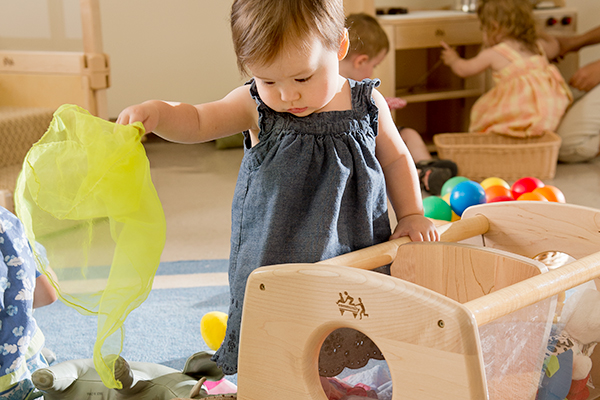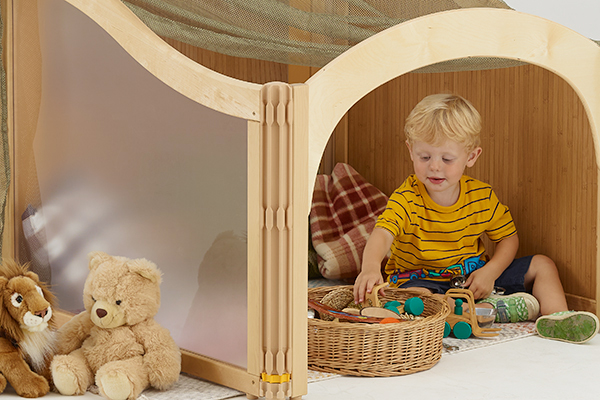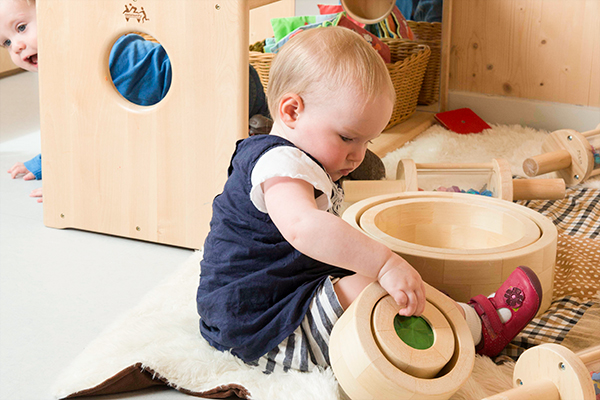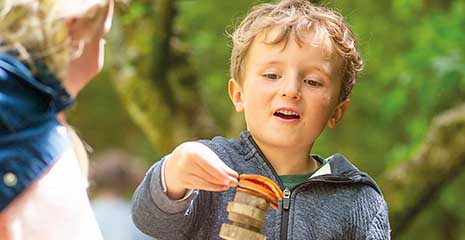Heuristic play
| June 2012What is heuristic play?
Heuristic play is rooted in young children’s natural curiosity. As babies grow, they move beyond being content to simply feel and ponder objects, to wanting to find out what can be done with them. Toddlers have an urge to handle things: to gather, fill, dump, stack, knock down, select and manipulate in other ways. Household or kitchen utensils offer this kind of activity as every parent knows, and can occupy a child for surprising stretches of time. When toddlers make an enjoyable discovery – for instance when one item fits into another, or an interesting sound is produced – they often repeat the action several times to test the result, which strengthens cognitive development as well as fine muscle control and hand/eye coordination.
In their book, People under Three, Elinor Goldschmied and Sonia Jackson coined the term heuristic play, to explain how to provide a more structured opportunity for this kind of activity. Heuristic play ‘consists of offering a group of children, for a defined period of time in a controlled environment, a large number of different kinds of objects and receptacles with which they play freely without adult intervention’. It is particularly useful for children in their second year who often seem unwilling to engage in any activity for more than a few minutes. According to the Oxford Dictionary, ‘heuristic’ means helping to find out or discover; proceeding by trial and error. It stems from the same root as Eureka – ‘I found it!’ Clare Crowther of Bridgwater College describes heuristic play as ‘an activity we use with one-year-olds, two-year-olds, and young threes, giving them the opportunity to experiment spontaneously with a wide range of non-commercial objects. Whilst the heuristic play session is in process, adults need to remain seated and quiet. This supports children in making their own choices and discoveries.’
Objects for heuristic play
Heuristic play with objects is not a novel idea. Consider children’s age-old fascination with mother’s sewing basket: while mum is mending, her child enjoys its contents in various combinations – reels of thread, bits of colourful tape, scraps of yarn and cloth, a pincushion full of pins, a measuring tape, small tins of snaps to shake (or match up and hitch together), and buttons in all shapes, sizes and colours to sort and arrange. Heuristic play represents the same concept, but takes place with groups of children and large quantities of each item.
To provide for heuristic play, practitioners collect natural materials like fir cones, conkers, seashells, and pebbles, as well as ribbons, short lengths of chain, and ‘found’ objects like curtain rings, jar lids, sturdy cardboard tubes, the circles from inside sellotape, and empty cotton reels. (I’ve noticed that the rings from empty sellotape rolls are particularly popular. Some are slightly sticky from the tape, so children enjoy attaching and detaching them. They are easier to pick up than curtain rings, are small enough to fit into other items, and have a centre through which fingers or objects can be poked.) Between sessions staff maintain the supplies, checking for cleanliness and safety, discarding unsuitable items and collecting new ones.
For the heuristic play session, a large floor area is freed for a specified period; an hour is good, allowing time for children to help pack up. One staff member makes heaps of the objects for play and distributes tins (at least three per child). It is important to provide large numbers of each item, so that children do not feel compelled to protect ‘their’ things from each other. Goldschmied and Jackson point out that it is premature to expect children to share at this age (page 132).
The social aspect of heuristic play
An intriguing aspect of heuristic play is its social quality. Although each child is engrossed in his or her own investigation, they are very aware of each other. In one session I observed, a child began tooting on a cardboard tube; then others started tooting on tubes or reels, and one child even held a tube to other children’s mouths. In another session, I made three heaps of objects in three corners, although there were only four children. All four gravitated to one heap where they played harmoniously, although they were practically – and sometimes literally – on top of each other. (The only squabble occurred over a jar lid: although there were many lids, only one had strawberries pictured on it!) Only after half an hour of playing in this close proximity did one, and then two, of the children wander off to other heaps.
The heuristic play session
The heuristic play session offers staff an opportunity to observe. Carers sit quietly nearby, where children take assurance from their presence. So much can be learned about each child when one removes oneself slightly from the action!
It’s exciting to witness the thought processes children display. I watched James slide a thin tube through a wider one, repeat the action, and then try to slide a larger object through the tube. He tried several times before rejecting the large object to try something else. Another child dropped a cork into a cone-shaped reel, tried unsuccessfully to reach it with her hand, shook the cone, and when the cork (to her surprise) flew out, repeated the procedure.
Discerning sound is part of heuristic play. Children often notice noises accidentally produced by some action (rubbing two rough items together, sliding a chain across a tin, treading on lids…) and purposely repeat the action, sometimes over and over again. The adults need to resist the urge to move them on to something else.
At the end of the session, children help pick up the objects. A two-year-old may manage to put items in the correct bag. Younger children do not seem to grasp this concept, and bring any item to pop into the bag. They enjoy the clean-up process as much as the play time – after all, dropping an item in a bag is as much fun as dropping it in a tin!
‘Heuristic play is an approach and not a prescription. There is no right way to do it and people in different settings will have their own ideas and collect their own materials’ (People under Three, page 130). I have seen heuristic play materials stored in homemade drawstring bags, in wicker baskets, and in browser boxes. Exactly how we provide this kind of activity does not matter, so long as we recognise the significance of spontaneous exploratory play for children’s development and offer them plentiful opportunities. Enjoy it!
References
People under Three, Young Children in Day Care (2nd edition), Elinor Goldschmied & Sonia Jackson, Routledge, London & New York, 2004







